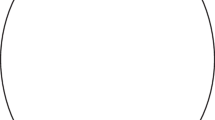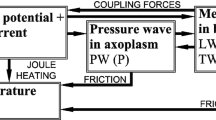Abstract
A theory which is based on a set of assumptions different from those of the sodium theory is developed. Here the mobile ions are considered to be distributed at Donnan equilibrium and the axoplasm is regarded as an analog of a cation-exchanger. Following the spirit of the Debye-Hückel theory, some important features of the ionic distribution and electrical potential of the nerve fiber have been calculated. The results appear to be in better agreement with the experimental observations than the Goldman-Hodgkin-Katz equation.
Similar content being viewed by others
Literature
Baker, P. F., A. L. Hodgkin and H. Meves. 1964. “The Effect of Diluting the Internal Solution on the Electrical Properties of a Perfused Giant Axon.”J. Physiol.,170, 541–560.
Bartlett, J. H. and R. A. Kromhout. 1952. “The Donnan Equilibrium.”Bull. Math. Biophys.,14, 385–391.
Caldwell, P. C. 1957. “The Sensitivity to pH of the Inhibitory Effects of Dinitrophenol on Squid Giant Axons.”Biochem. J.,67, 1p-2p.
Chang, D. C. 1975. Unpublished data.
Curtis, H. J. and K. S. Cole. 1940. “Membrane Resting and Action Potentials from the Squid Giant Axon.”J. Cell. Comp. Physiol.,19, 135–144.
Damadian, R. 1971. “Biological Ion Exchange Resins—I. Quantitative Electrostatic Correspondence of Fixed Charge and Mobile Counter-Ion.”Biophys. J.,11, 739–760.
— 1973. “Biological Ion Exchanger Resins.”Ann. N.Y. Acad. Sci.,204, 211–244.
Davson, H. 1970.A Textbook of General Physiology. Baltimore: Williams and Wilkins.
Dean, R. B. 1941. “Theories of Electrolyte Equilibrium in Muscle.”Biol. Symp.,3, 331–348.
Diamond, J. M. and E. M. Wright. 1969. “Biological Membrane: The Physical Basis of Ion and Non-electrolyte Selectivity.”A. Rev. Physiol.,31, 581–645.
Eisenman, G. 1968. “Ion Permeation of Cell Membranes and its Models.”Fed. Proc.,27, 1249–1251.
Freeman, J. C. 1973. “Do Red Cells Ghosts Pump Sodium or Potassium?”Ann. N.Y. Sci.,204, 609–615.
Goldman, D. E. 1943. “Potential, Impedance, and Rectification in Membranes.”J. Gen. Physiol.,27, 37–60.
Grundfest, H., C. Y. Kao and M. Altamirano. 1954. “Bioelectric Effects of Ions Micro-injected into the Giant Axon of Loligo.”J. Gen. Physiol.,38, 245–282.
Gunn, R., P. F. Curran and C. Patlak. 1968. “Experimental and Theoretical Evaluation of Total Potential at Zero Current as Given by the Constant Field Equation (D. Goldman) for a Cation Exchange Membrane in NaCl Solution.”Biophys. J.,8(A), 173.
Hodgkin, A. L. 1958. “Ionic Movement and Electrical Activity in Giant Nerve Fibres.”Proc. R. Soc.,148B, 1–37.
— and A. F. Huxley. 1952. “Current Carried by Sodium and Potassium Ions Through the Membrane of the Giant Axon of Loligo.”J. Physiol.,116, 449–472.
— and —. 1952. “The Components of Membrane Conductance in the Giant Axon of Loligo.” —Ibid.,,116, 473–496.
— and —. 1952. “The Dual Effect of Membrane Potential on Sodium Conductance in the Giant Axon of Loligo.” —Ibid.,,116, 497–506.
— and —. 1952. “A Quantitative Description of Membrane Current and Its Application to Conduction and Excitation in Nerve.” —Ibid.,,117, 500–544.
— and B. Katz. 1949. “The Effect of Sodium Ions on the Electrical Activity of the Giant Axon of the Squid.” —Ibid.,,108, 37–77.
— and R. D. Keynes. 1955. “Active Transport of Cations in Giant Axons from Sepia and Loligo.” —Ibid.,,128, 28–60.
Hurlbut, W. P. 1970. “Ion Movements in Nerve.” InMembranes and Ion Transport, Bittar, E. E., ed., Vol. 2, pp. 95–144. London: Wiley-Interscience.
Karreman, G. 1964. “Adsorption of Ions at Charged Sites and Phase Boundary Potentials.”Bull. Math. Biophys.,26, 275–290.
—. 1973. “Toward a Physical Understanding of Physiological Excitation as a Cooperative Specific Adsorption Phenomenon.” —Ibid.,,35, 149–171.
Katz, B. 1966.Nerve, Muscles and Synapse. New York: McGraw-Hill.
Keynes, R. D. and G. W. Maisel. 1954. “The Energy Requirement for Sodium Extrusion from a Frog Muscle.”Proc. R. Soc., Series B,142, 383–392.
Koketsu, K. and Y. Kimura. 1960. “The Resting Potential and Intracellular Potassium of Skeletal Muscle in Frogs.”J. Cell. Comp. Physiol.,55, 239–244.
Levi, H. and H. H. Ussing. 1949. “Exchange of Sodium and Chloride in Frog Muscle.”Acta Physiol. Scand.,16, 232–249.
Ling, G. N. 1952. “The Role of Phosphate in the Maintenance of the Resting Potential and Selective Ionic Accumulation in Frog Muscle Cells.”Phosphorous Metabolism, McElroy, W. D. and Glass, B., eds., Vol. 2, pp. 748–795. Baltimore: Johns Hopkins Press.
—. 1960. “The Interpretation of Selective Ionic Permeability and Cellular Potentials in Terms of the Fixed Charge-Induction Hypothesis.”J. Gen. Physiol. Suppl.,43, 149–174.
—. 1962.Physical Theory of the Living State. Philadelphia: Balisdell.
—. 1965a. “Physiology and Anatomy of the Cell Membrane: The Physical State of Water in the Living Cell.”Fed. Proc.,24(2), 103–112.
—. 1965b. “The Membrane Theory and Other Views for Solute Permeability, Distribution, and Transport in Living Cells.”Perspect. Biol. Med.,9, 87–105.
—, C. Miller and M. M. Ochsenfeld. 1973. “The Physical State of Solutes and Water in Living Cells according to the Association-Induction Hypothesis.”Ann. New York Acad. Sci.,283, 6–47.
Landahl, H. D. 1953. “Note on the Donnan Equilibrium.”Bull. Math. Biophys.,15, 153–159.
Maizels, M. 1951. “Factors in the Active Transport of Cations.”J. Physiol.,112, 59–83.
Minkoff, L. and R. Damadian. 1973a. “Caloric Catastrophy.”Biophys. J.,13, 167–178.
— and —. 1973b. “Energy Requirements of Bacterial Ion Exchange.”Ann, New York Acad. Sci.,204, 249–260.
Proverbio, F., M. Condrescu-Guidi and G. Whittenbury. 1975. “Ouabain-Insensitive Na+ Stimulation of an Mg2+-Dependent ATPase in Kidney Tissue.”Biochim. Biophys. Acta,293, 281–292.
Reichenberg, D. 1969. “Ion-Exchange Selectivity.”Ion-Exchange,1, 227–275.
Romualdez, A. G. and R. I. Sha'afi. 1975. “Effect of ATP on Sodium and Potassium Transport in Dog Erythrocytes.”Fed. Proc.,34(3), 237.
Singer, I. and I. Tasaki. 1968. “Nerve Excitability and Membrane Macromolecules.” InBiological Membranes: Physical Facts and Function, Chapman, D., ed., pp. 347–410. New York: Academic Press.
Tasaki, I. 1968.Nerve Excitation: A Macromolecular Approach. Springfield, Illinois: Charles C. Thomas.
—, I. Singer and T. Takenaka. 1965. “Effect of Internal and External Ionic Environment on Excitability of Squid Giant Axon.”J. Gen. Physiol.,48, 1095–1123.
— and T. Takenaka. 1964. “Ion Fluxes and Excitability in Squid Giant Axon.” InThe Cellular Function of Membrane Transport. Hoffman, J. F., ed., pp. 95–111. Englewood Cliffs: Prentice-Hall.
Troshin, A. S. 1966.Problem of Cell Permeability. Oxford: Pergamon Press.
Wei, L. Y. 1969. “Molecular Mechanisms of Nerve Excitation and Conduction.”Bull. Math. Biophys.,31, 39–58.
Wiggins, P. M. 1973. “Ionic Partition between Surface and Bulk Water in Silica Gel.”Biophys. J.,13, 385–398.
Yeh, H., F. J. Brinley and E. D. Becker. 1973. “Nuclear Magnetic Resonance Studies on Intracellular Sodium in Human Erythrocytes and Frog Muscle.”Biophys. J.,13, 56–71.
Author information
Authors and Affiliations
Additional information
A summary of this work has been reported in the 1974 March meeting of the American Physical Society and the 1976 annual meeting of the Biophysical Society.
Rights and permissions
About this article
Cite this article
Chang, D.C. A physical model of nerve axon—I. Ionic distribution, potential profile, and resting potential. Bltn Mathcal Biology 39, 1–22 (1977). https://doi.org/10.1007/BF02460678
Received:
Revised:
Issue Date:
DOI: https://doi.org/10.1007/BF02460678




